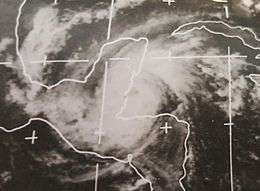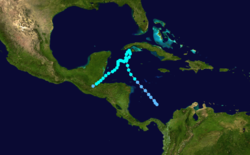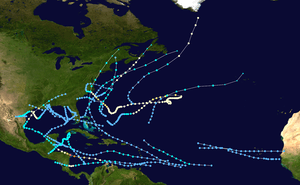Tropical Storm Laura (1971)
Tropical Storm Laura was the final storm in the active 1971 Atlantic hurricane season. It formed on November 12 in the western Caribbean Sea, and reached winds of 70 mph (120 km/h) as it approached western Cuba. Across the island, Laura produced heavy rainfall, peaking at 32.5 inches (83 cm). The resulting flooding killed one person and caused crop damage. 26,000 people were forced to evacuate their homes. Initially, Laura was forecast to move across the island and impact the southern United States, but it executed a small loop and turned to the southwest. The storm moved ashore on Belize, one of only four November storms to affect the country. Little impact occurred during Laura's final landfall, and it dissipated on November 22 over central Guatemala.
| Tropical Storm (SSHWS/NWS) | |
 Tropical Storm Laura approaching Central America | |
| Formed | November 12, 1971 |
|---|---|
| Dissipated | November 22, 1971 |
| Highest winds | 1-minute sustained: 70 mph (110 km/h) |
| Lowest pressure | 994 mbar (hPa); 29.35 inHg |
| Fatalities | 1 reported |
| Damage | Minimal |
| Areas affected | Cayman Islands, Cuba, Central America |
| Part of the 1971 Atlantic hurricane season | |
Meteorological history

Tropical Storm Laura began in a large area of convection across the southwest Caribbean Sea in mid-November. On November 12, a tropical depression formed about 175 miles (280 km) north of Panama. It moved northwestward, slowly organizing and becoming a tropical storm on November 14. Receiving the name Laura, the storm continued to intensify as it turned northward toward western Cuba; late on November 15, it attained peak winds of 70 mph (110 km/h).[1] Originally, the National Hurricane Center anticipated Laura would attain hurricane status,[2] as well as for it to continue northward into the Gulf of Mexico. Although a cold front was expected to bring the storm to the north, a ridge instead increased over the southeastern United States, which prevented Laura from moving ashore.[1]
Tropical Storm Laura maintained peak winds for about 48 hours, during which a minimum pressure of 994 hectopascals (29.4 inHg) was recorded. Steering currents were initially weak, which caused the storm to drift toward the northeast, before the ridge to its north forced the storm to the southwest; by late on November 17, Laura finished executing a clockwise loop.[1] Its path to the southwest away from Cuba was unusual; only two other storms on record – a hurricane in 1888 and Hurricane Ike in 2008 – had a southward element in their path when they affected Cuba, and each struck the northern coast of the country.[3] Laura weakened as it turned westward and later to the south and southwest. After the winds decreased to 50 mph (85 km/h), however, the storm began re-intensifying as it approached Central America. Late on November 20, Laura again reached peak winds of 70 mph (120 km/h), which was maintained for 30 hours until the storm made landfall in Punta Gorda, Belize. Early on November 22, the system dissipated over central Guatemala.[1]
Preparations and impact
| Precipitation | Storm | Location | Ref. | ||
|---|---|---|---|---|---|
| Rank | mm | in | |||
| 1 | 2,550 | 100.39 | Flora 1963 | [4] | |
| 2 | 1,092 | 42.99 | Dennis 2005 | [4] | |
| 3 | 1,025 | 40.35 | T.D. #1 1988 | [4] | |
| 4 | 1,012 | 39.84 | Alberto 1982 | [4] | |
| 5 | 870 | 34.25 | Frederic 1979 | [4] | |
| 6 | 849 | 33.43 | T.D. #1 1992 | [4] | |
| 7 | 825 | 32.48 | Laura 1971 | [4] | |
| 8 | 800 | 31.50 | Irene 1999 | [4] | |
| 9 | 754 | 29.69 | Michelle 2001 | [4] | |
| 10 | 747 | 29.41 | Lili 1996 | [4] | |
When Tropical Storm Laura first passed the Cayman Islands, it produced up to 3 inches (7.5 cm) of rainfall.[2] As it was slowly moving off of the coast of Cuba, Laura dropped heavy rainfall, including nearly 20 inches (50 cm) across most of the Isle of Youth;[1] one station on the island reported 14 inches (36 cm) in 24 hours.[5] The highest total in the country was 32.5 inches (83 cm), and overall the storm impacted four provinces, including Isle of Youth, Pinar del Río, La Habana, and the city of Havana.[6] On the Isle of Youth, Laura produced winds of 70 mph (120 km/h), with gusts to 80 mph (130 km/h).[1] On the mainland, the storm destroyed 20 homes and several tobacco sheds,[1] with damage also reported to the coffee, sugar, fruit, and vegetable crops. Due to the flooding, officials forced 26,000 people from their homes in Pinar del Río, and one person in that province drowned while crossing a river.[7] The storm's passage was believed to have diverted a flock of great black-backed gulls toward Central America and north-coastal South America; the species is usually found in the Mid-Atlantic states, and were migrating to the Gulf Coast or Cuba when they were affected by the storm.[8]
When Laura's path was uncertain, forecasters advised fishermen to remain at port along the Yucatan Peninsula and southern Florida.[2] Gale warnings were also issued for the Florida Keys, due to the uncertainty.[5] No significant damage or casualties were reported in Central America,[1] although heavy rainfall was reported across the region.[9] On Glover's Reef off the coast of British Honduras (now Belize), the storm stranded a group of about 20 scientists affiliated with the Smithsonian Institution; the group was affected by the strong winds and rains, and required rescue. The storm damaged several buildings along the mainland.[10]
Laura was one of only four storms to form in November and affect Belize, the others being a tropical storm in 1898, a hurricane in 1942, and Hurricane Ida in 2009.[11]
See also
- Other storms of the same name
References
- R.H. Simpson and John Hope (1971). "Atlantic Hurricanes of 1971" (PDF). National Hurricane Center. Retrieved 2010-02-26.
- Associated Press (1971-11-13). "Tropical Storm Laura Could Become Hurricane". Retrieved 2010-02-26.
- Margarita Barrios (2008-10-12). "Parte meteorológico: sin magia ni hechicería". Juventud Rebelde. Retrieved 2010-02-26.
- Instituto Nacional de Recursos Hidráulicos (2012). "Lluvias intensas observadas y grandes inundaciones reportadas" (in Spanish). Archived from the original on November 5, 2013. Retrieved April 25, 2016.
- Associated Press (1971-11-17). "Laura Wallowing in Vicious Circle". Retrieved 2010-02-27.
- Instituto Nacional de Recursos Hidráulicos (2003). "Lluvias intensas observadas y grandes inundaciones reportadas" (in Spanish). Archived from the original on 2007-03-12. Retrieved 2007-02-10.
- Associated Press (1971-11-19). "Laura Weakens off Yucatan Coast". Retrieved 2010-02-27.
- V.H. Voous. "Northern Gulls in Aruba" (PDF). University of Amsterdam. Archived from the original (PDF) on 2011-07-24. Retrieved 2010-02-26.
- Associated Press (1971-11-21). "Tropical Storm Hits Honduras". Retrieved 2010-02-27.
- Saint Petersburg Times Wire Services (1971-11-22). "Laura Hits Honduras, Strands 20". Retrieved 2010-02-27.
- 7 News Belize (2009-11-05). "Ida Weakens". Retrieved 2010-02-27.
